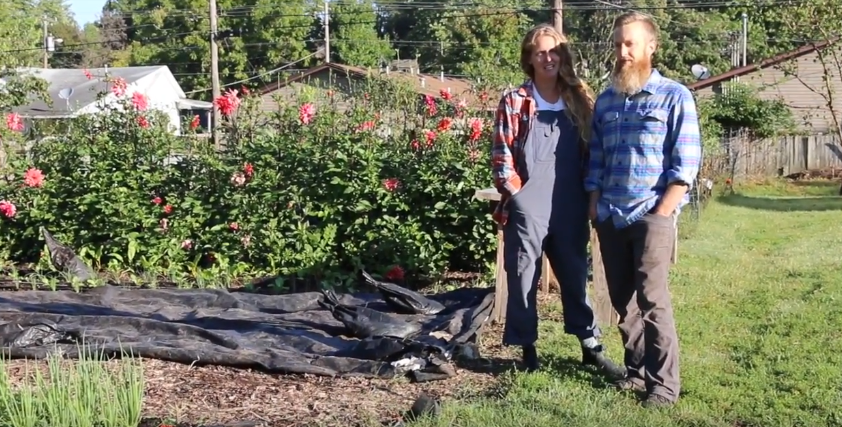Mar 13, 2019Urban Farmers focus on soil health for sustainable intensification
Developing and maintaining healthy soils is a vital activity for producers. For urban producers, issues such as soil contamination and compaction are major concerns, but soil productivity is also a primary focus for growers who aim to intensify production on a small plot of land. Simply put, sustainable intensification optimizes resource utilization and management. On the same area of land, producers use fewer inputs and generate greater yields (United Nations FAO, 2017).
At Urban Roots Farm in downtown Springfield, Missouri, owners Adam and Melissa Millsap have been farming and sustainably intensifying their operation since 2010. They have introduced high tunnels, bio-intensive crop planning and successions, and soil management strategies on .5 acres of urban land. Today, they harvest more than 500 pounds of produce per week, offering a 24-week vegetable community supported agriculture subscription (CSA) as well as a winter CSA. Because they’re committed to the local food community in Springfield, they offer locally produced eggs, bread, mushrooms, and coffee in their CSA shares as well. As their farm grows, the Millsaps have looked for innovative ways to sustainably intensify production, but they have concerns about depleting their soil health with intensive production.
“We are always seeking methods, tools, and philosophy with the potential to make our farm more productive, more sustainable, and more efficient,” said Adam Millsap. “The natural nutrient cycle dictates that a farm, which strives to operate within the constructs of nature, return as much plant matter to the soil as possible. Of course for this plant matter to be converted back into useful nutrients takes time and space, two commodities often in short supply on a tiny vegetable farm.”
Millsap says that to remain profitable, they need to plant a new crop as quickly as possible after harvest, which limits the time available to allow soils to rest, and affords little opportunity to allow crop residues to decompose in place. With support from a $6,334 NCR-SARE Farmer Rancher grant in 2015, Millsap started to work on a method for getting crop residues to rapidly decompose in place, hoping that they could drastically reduce the labor and tillage required to return nutrients to their soil. Prior to the grant project, the Millsaps had been moving coarse crop residues to a compost pile and incorporating fine residues with multiple passes of a rototiller. They would then move finished compost back to the bed, and till again to prepare a suitable seed bed.
“We spent a lot of time moving things to and from the bed, and eroding our soil structure through repeated tillage, in order to effectively recycle plant nutrients,” explained Millsap.
Taking the advice of Jean Martin Fortier (author, The Market Gardener, 2014), they tested a system of using a flail mower, opaque plastic sheeting, and a rotary harrow to cycle nutrients, purge weed seed from the soil, and prepare beds for successive planting. After harvest in 2015, they set aside a test plot to begin their experiment. First, they used a flail mower to finely shred the crop residues in the field. Next, they covered the residues with high quality silage tarps to create suitable conditions for decomposing microorganisms. After 1-3 weeks, they removed the sheeting and used a rotary harrow (instead of a rototiller) to prepare their soil for planting. Finally, they planted their crops. After the first year, they immediately noticed improvements.
“It would not be an overstatement to say this system is revolutionizing our operation,” said Millsap.
Millsap says the system has improved their labor situation, yields, and soil conditions. They have reduced the labor needed to move materials around, manage weeds, prepare products for market, and prepare beds for planting. Their soil structure is significantly less compacted, and requires less work prior to planting. Although their planting beds are not re-cropped as quickly since implementing the system, they have found that with the reduction of weed pressure, and reduction of prep time required for planting, they are able to have a larger percentage of beds in production because they are able to plant them as soon as they are ready. Reluctant to use more plastic on their urban farm, the Millsaps purchased high quality silage tarps, which they hope will last several seasons—they expect to see a reduced need to cover the beds as the weed bank is depleted.
“The ideas we implemented through this grant were not new ideas, but ideas which are not yet in widespread use,” said Millsap. “It is our hope that we can continue to provide a functioning model for innovations which improve the profitability of micro and small scale farming. We talk about this project with everyone who shows the slightest interest, and it’s our hope they will do the same after they’ve given it a try.”
Want more information? See the related SARE grant(s) FNC15-1006, Evaluation of efficiency and efficacy of a method for managing the nutrient cycle on a bio-intensive micro-farm.















